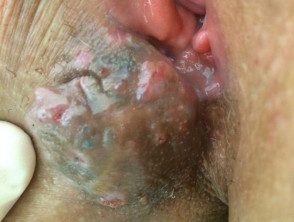What is endometriosis?
The endometrium is the lining of the uterus (womb). Endometriosis is the growth of endometrial tissue outside the uterus. It usually arises near the uterus inside the pelvis, the lower abdomen. The mass is also called an 'endometrioma'. Endometriosis outside of the pelvis occurs in approximately 12% of women with endometriosis.
What is it cutaneous endometriosis?
Cutaneous endometriosis is endometriosis on the skin and is rare. It was first described by Villar in 1860. It commonly occurs in surgery incision from previous gynecologic or abdominal surgery, such as a cesarean section, hysterectomy, or laparoscopic surgery, but it can also develop spontaneously. It's also called 'scar endometriosis'.
The most common sites for cutaneous endometriosis are the abdominal wall, the belly button and limbs.
What Causes Cutaneous Endometriosis?
There are two theories about the cause of spontaneous cutaneous endometriosis.
- The transport theory states that endometrial cells are transported out of the uterus through the lymphatic system or other route.
- The metaplasmic theory states that endometrial cells can develop in the coelomic mesothelium in the presence of estrogen levels or other stimulus.
What are the clinical features of cutaneous endometriosis?
Women with cutaneous endometriosis may have the following signs and symptoms.
- A palpable subcutaneous dough; This can cause cramps and bleeding during the monthly period and is sometimes called “menstruation. tumor“.
- The dough is generally firm and can be blue, black, brown, or red in color.
- Typical size range for mass averages 0.5–6 mm in diameter.
- The patient may complain of itching, swelling, or tenderness.
Cutaneous endometriosis in the perineum.

Cutaneous endometriosis
What complications arise from cutaneous endometriosis?
Complications of cutaneous endometriosis include:
- Local reappearance after surgery excision
- Endometrial development carcinoma (this is rare)
Malignancy should be suspected if the mass is abnormally large, has grown rapidly, or has recurred afterwards splits.
How is cutaneous endometriosis diagnosed?
The diagnosis of cutaneous endometriosis is based on:
- Patient history, including gynecological and surgical history.
- Physical exam
- Ultrasound (ultrasound test)
- Doppler examination of the soft tissues abdominal wall
- Computed tomography
- Magnetic resonance imaging
- Skin biopsy
Histopathology is the key to an accurate diagnosis and detects the endometrial glands, stroma and hemosmosin if present.
Diagnosis is often delayed due to confusion with other conditions, including hematoma, neuroma, hernia and neoplastic tissue.
What is the treatment for cutaneous endometriosis?
The main treatment for cutaneous endometriosis is surgical excision of the mass, preserving the umbilicus whenever possible and if relevant.
Medical therapy uses the hormones danazol, progesteroneand gonadotropin-releasing hormone (GnRH).

